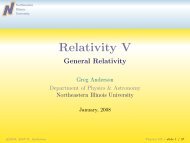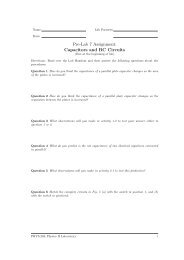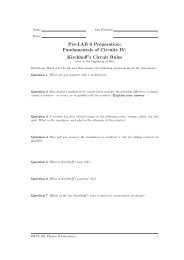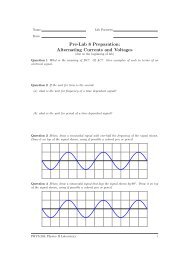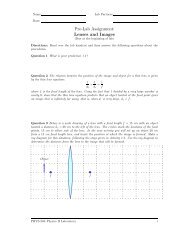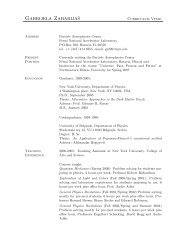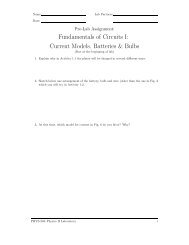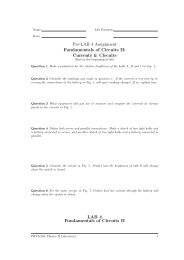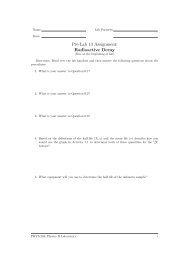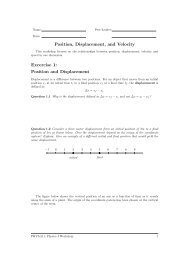Lab & Pre-lab #5: Voltage
Lab & Pre-lab #5: Voltage
Lab & Pre-lab #5: Voltage
Create successful ePaper yourself
Turn your PDF publications into a flip-book with our unique Google optimized e-Paper software.
Fundamentals of Circuits III: <strong>Voltage</strong> & Ohm’s Law v 0.1• connecting wires• alligator clipsThe circuit shown below contains a power supply. A power supply has the same purposeas a battery. Both raise the potential energy of the electric charges that flow through them;the battery uses chemical energy to do this, while the power supply uses electrical energy. Avariable DC power supply lets you adjust the potential difference. When you turn the dial, youchange the voltage between its terminals. Therefore, this circuit allows you to measure how thecurrent through the resistor varies as you change the potential difference across it.CP2DC Power Supply+−+ −+−VP1Figure 9: Circuit with a variable power supply to explore the relationship between current andpotential difference for a resistor.<strong>Pre</strong>diction 3.1 What will happen to the current through the resistor as you increase the appliedvoltage from zero?<strong>Pre</strong>diction 3.2 What will happen to the potential difference across the resistor as the currentthrough it increases from zero?<strong>Pre</strong>diction 3.3 What do you predict for the mathematical relationship between the potentialdifference across the resistor and the current through the resistor?Activity 3.1: Current and Potential Difference for a ResistorStep 1: Open the experiment file called L4A3-1 (Ohm’s Law).Step 2: Zero both probes with nothing connected to them.Step 3: Be sure the power supply is turned off. Also, check to see that the voltage control(the knob on the left) is turned down all the way (counter clockwise). Connect the circuitin Fig. 9. Note that the current probe is connected to measure the current through theresistor, and the voltage probe is connected to measure the potential difference across theresistor.Step 4: Turn on the power supply. Begin graphing current and voltage starting with the powersupply set to zero voltage, and graph as you turn the voltage control up slowly to about3 volts.Warning: Do not exceed 3 volts!PHYS-204:Physics II <strong>Lab</strong>oratory 12




